
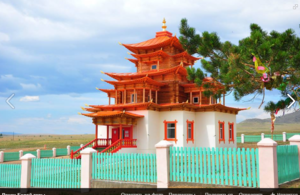
Atsaysky datsan "Tubden Darzhaling" is one of the oldest Buddhist Gelug monasteries in Buryatia, which operated from 1743 to 1935.


Atsaysky datsan "Tubden Darzhaling" is one of the oldest Buddhist Gelug monasteries in Buryatia, which operated from 1743 to 1935.
In 1743, in the north-east side of Goose Lake, in the mouth of the river Zagustay Selenge Buryats, put the temple arc represent a felt yurt.
The first shireete (superiors) are Lama, who arrived from Tibet.
Later wooden Tsogchen arc was built, with the Tibetan name Tubden Darzhaling.
In the 1930s during the anti-religious persecution lamas were persecuted, and he was eliminated datsan decision.
By 1945, all the buildings of the complex were demolished.
In 2012-2014, the Palace complex erected White Tara.
The temple-Dugan conducted daily services.
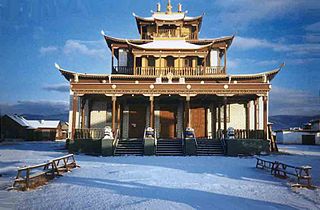
Datsan is the term used for Buddhist university monasteries in the Tibetan tradition of Gelukpa located throughout Mongolia, Tibet and Siberia. As a rule, in a datsan there are two departments—philosophical and medical. Sometimes a department of tantric practices is added to them where the monks study only after finishing education in the philosophical department.
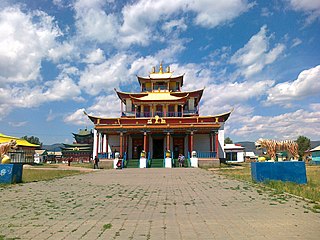
Ivolginsky Datsan is the center of the Buddhist Traditional Sangha of Russia. It is a Buddhist temple located in Buryatia, Russia, 23 km from Ulan Ude, near Verkhnyaya Ivolga village.

Dashi-Dorzho Itigilov also transcribed at Etigelov or Itigelov was a Buryat Buddhist lama and the 12th Pandito Khambo Lama in the Tibetan Buddhist tradition.

The Putuo Zongcheng Temple of Chengde, Hebei province, China is a Qing dynasty era Buddhist temple complex built between 1767 and 1771, during the reign of the Qianlong Emperor (1735–1796). It is located near the Chengde Mountain Resort, which is south of the Putuo Zongcheng. Along with the equally famed Puning Temple, it is one of the Eight Outer Temples of Chengde. The temple was modeled after the Potala Palace of Tibet, the residence of the Dalai Lama built a century earlier. Since it was modeled after the Potala palace, the temple represents a fusion of Chinese and Tibetan architectural styles. The temple complex covers a surface area of some 220,000 square metres (2,400,000 sq ft), making it one of the largest in China. Many of its halls and pavilions are adorned with copper and gold tiled roofs, adding to the splendor of the site.
Tsetserleg is a sum of Khövsgöl aimag, Mongolia. The area is 7,480 km2, of which 6,040 km2 are pasture and 1,340 km2 are forest. 15 km2 are farmland. In 2000, Tsetserleg had a population of 5,876 people, mainly Khotgoid. The sum center, officially named Khalban, is located 209 km west of Mörön and 880 km from Ulaanbaatar.

Thiksey Monastery or Thiksey Gompa is a Buddhist monastery affiliated with the Gelug school of Tibetan Buddhism. It is located on top of a hill in Thiksey approximately 19 kilometres (12 mi) east of Leh, in the Ladakh region of northern India. It is noted for its resemblance to the Potala Palace in Lhasa, Tibet, and is the largest monastery in central Ladakh, notably containing a separate set of buildings for female renunciates that has been the source of significant recent building and reorganization.

Agvan Lobsan Dorzhiev was a Russian-born monk of the Gelug school of Tibetan Buddhism, sometimes referred by his scholarly title as Tsenyi Khempo. He was popularly known as the Sokpo Tsеnshab Ngawang Lobsang to the Tibetans.

Dulduityn Danzanravjaa was a prominent Mongolian writer, composer, painter, Buddhist scholar, physician and the fifth Noyon Khutagt, the Lama of the Gobi. His name is a Mongolian adaptation of the last part of the Tibetan name Lobsang Tenzin Rabgye given to Danzanravjaa by the fourth Bogd Gegeen on his visit to the Mongolian capital, Urga, in 1812 – where Danzanravjaa was also recognized as an Incarnate Lama. There are several versions concerning the origins and use of "Dulduityn". He was the fifth incarnation of the Gobi Noyon Khutagt, which is the title of a prominent line of tulkus of the Nyingmapa lineage of Tibetan Buddhism in Mongolia and was found by the personal attendant of the fourth Noyon Khutagt in 1809. It was not possible to enthrone Danzanravjaa as the fifth Noyon Hutagt because of the ban from the ruling Manchu (Qing) dynasty on recognition of this line of incarnations. Mongolia at the time was under Manchurian Qing control. He was enthroned as the Avshaa Gegeen in Ongiin Gol Monastery by Ishdonilhudev Rinpoche. He is primarily famous for his poetry, but is also known for his prophecies, and treatises on medicine, philosophy, and astrology.
Vụ Bản is a rural district of Nam Định province in the Red River Delta region of Vietnam. As of 2003 the district had a population of 130,672. The district covers an area of 148 km2. The district capital lies at Gôi. The district includes the Vân Cát temple. During the 1920s the area was administered by the Vụ Bản district mandarin.

Gusinoye Ozero is a village (selo) in Selenginsky District of the Buryat Republic, Russia, located on the south-western shore of Lake Gusinoye, Selenga Highlands. Population: 3,268 (2002 Census); 4,219 (1989 Soviet census). Gusinoye Ozero is the second most populated inhabited locality of Selenginsky District.

Historically, Buddhism was incorporated into Siberia in the early 17th century. Buddhism is considered to be one of Russia's traditional religions and is legally a part of Russian historical heritage. Besides the historical monastic traditions of Buryatia, Tuva and Kalmykia, the religion of Buddhism is now spreading all over Russia, with many ethnic Russian converts.
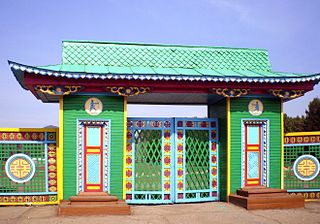
The Ulan-Ude Ethnographic Museum is an outdoor museum, located in the village Upper Berezovka, eight kilometres northeast of Ulan-Ude, Buryatia.

The Xumi Fushou Temple is one of the Eight Outer Temples in Chengde, Hebei, China. This Buddhist temple is in the north of the park complex of the Chengde Mountain Resort, to the east of Putuo Zongcheng Temple on the north side of a slightly upward slope hill. The temple covers an area of 37,900 m2 (408,000 sq ft).
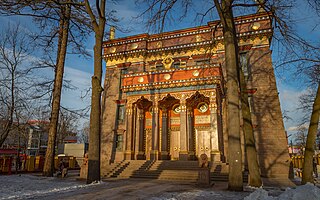
The Datsan Gunzechoinei is a large Buddhist temple in Saint Petersburg, Russia. It is the northernmost Buddhist temple in Russia.

Buddhism in Buryatia, a region in Siberia, Russia, has a deep-rooted history dating back to the 17th century when Tibetan Buddhism first arrived in the area. Initially adopted by ethnic groups like the Selenga and Zede Buryats, Buddhism gradually spread throughout the Transbaikal region. In 1741, it gained formal recognition as an official religion in the Russian Empire, with the establishment of Buddhist monastic universities known as datsans. Despite facing significant challenges during the Soviet era, including persecution and the closure of religious institutions, Buddhism in Buryatia has persisted and experienced a revival in the post-Soviet period.
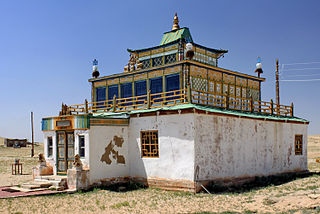
Khamar Monastery, founded in 1820, was an important Red Hat sect Buddhist monastic, cultural, and education center in Mongolia’s Gobi Desert region until its destruction in 1937. It was rebuilt in 1990. Today it is located in Khatanbulag district, Dornogovi Province, approximately 47 km south of the provincial capital Sainshand. At its height, the monastery reportedly accommodated over 80 temples and some 500 monks.

Tseezhe-Burgaltaysky datsan is the Buddhist Temple located in Buryatia, Russia.
The Central Spiritual Board of Buddhists of the USSR (TsDUB) was the authorized organization for Buddhists in the Soviet Union.

Damba Badmaevich Ayusheev is the 24th and incumbent Pandito Khambo Lama.

Rinchin Datsan is a Buddhist monastery in Sovetsky City District of Novosibirsk, Russia. It was opened in 2015.